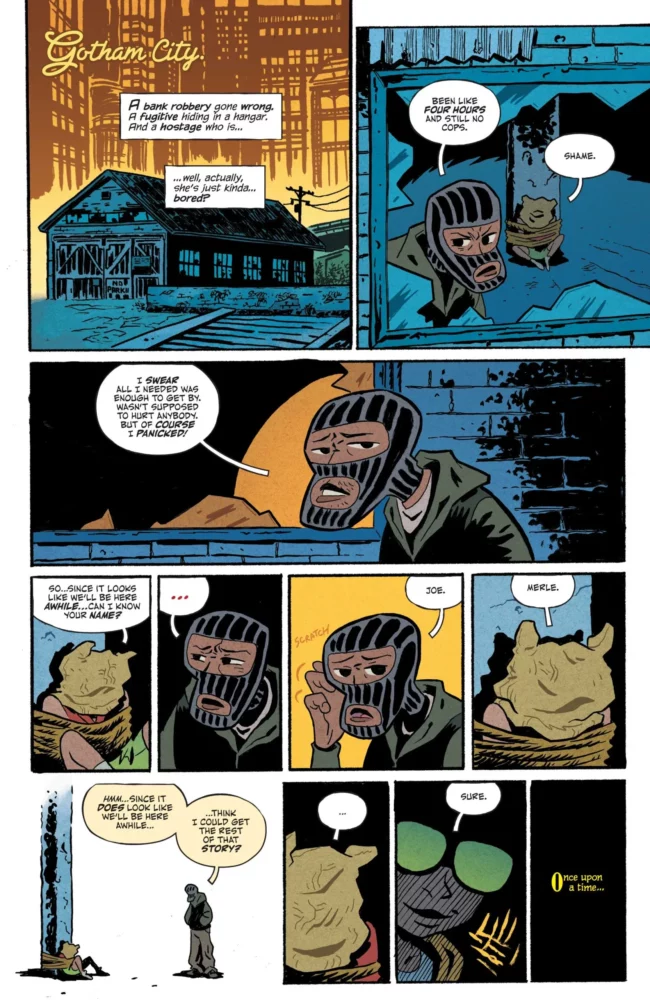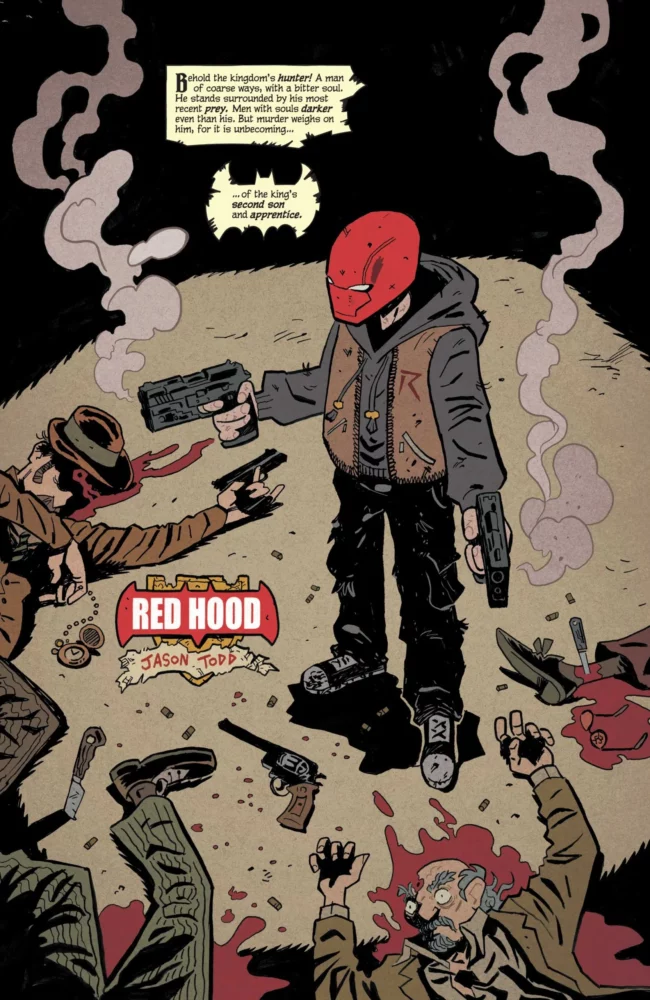The Boy Wonder #2 is the second issue in DC Comics’ mini-series following Damian Wayne and his adventures with some of the other previous Robins. The issue is both written and drawn by Juni Ba, with colors by Chris O’Halloran and letters by Aditya Bidikar.
The issue starts with a young girl being held hostage by a man named Joe. The two are both bored, so the girl continues telling him the story that she started last issue. She tells the story of the Red Hood, Jason Todd. She talks about how people are scared around him, and how people believe he shouldn’t be idolized. Damian Wayne appears to Jason and tries to get him to come out on a mission with him, which Red Hood reluctantly agrees to. They depart and find themselves against a demon instructed with helping show them what they run from.
WRITING
Ba’s selected narrator should be a topic of discussion. It’s not one of the Robins themselves, but rather a little girl being held hostage by a generic criminal. She’s not a scared little girl, just a bored one. How she knows these stories of Damian and his brothers, we don’t yet know. Something interesting is that she never directly references the story of the Batfamily. She speaks of kingdoms and kings and sons and apprentices, but not once of Gotham or Batman. She uses this metaphor, and displays Jason, “the second son of the king,” as coarse and bitter. Jason is shown living a hard life, but it’s not told in an unfair way. Ba acknowledges the hardship that Jason has faced and uses that to educate the reader. He’s not just grumpy to be grumpy. He’s actually fairly passive for the first chunk of the issue. We’re given context clues through the narration, but also through the world around him. How people react to him and how he reacts back shows how the public views him, but also how he can’t help but let it get to him no matter how hard he tries.

Ba compares and contrasts the Robins on a deeper level than what we’re used to. The story isn’t really told through Damian, but through Damian’s relationship with the other characters. This shows the similarities between Jason and Damian that Ba succeeds in highlighting. Jason reacts to the world around him because of how it acts towards him. Damian reacts to Jason’s story because of how he feels connected to it. Neither can run from their demons. It’s an interesting contrast from the last issue, where Damian was trying to prove himself to be better than Nightwing. Ba understands Damian’s nature, and his desire to be accepted by his mother and father. He understands that Damian believes he can only achieve that by being the best, and shows us that.
ART
Ba also draws the issue, and that really helps him in telling the story. He’s able to juggle this deep and sometimes dark storytelling with these highly expressive characters, but it doesn’t feel out of the ordinary. Well, it does, but that’s because it’s supposed to. It feels almost like a storybook. The reader isn’t being shown what’s happening, but we’re being told from a different perspective. We’re told the story of a king, his sons, and his kingdom, and we’re shown these characters in that style. You could rip any single panel out of a medieval storybook and it would fit. Ba shows how the world and what happens around each character affects them in an exaggerated way, but one that really gets the point across. Jason’s mask is more scribbled the more frustrated he gets. Damian is passionate and emotional when things don’t go his way. Ba is a reactive storyteller, and he makes that clear in this part of his story.

COLORS
With O’Halloran on colors, new life is brought to the comic. He especially excels in displaying Jason’s trauma. There’s a scene where Jason is forced to relive a moment from his past, and everything around him is flooded with green. It returns to normal, but when it’s brought to his attention again, we’re faced with that same green once more, only cracked this time. There’s a moment where Jason is with Damian and a black background is behind him. Damian says something that catches Jason off guard, and so the black background behind him shatters to show a red behind it. It’s who Jason is, but he covers it up behind this mask he puts on. O’Halloran excels with these small details, and the issue is better for it.
LETTERS
Bidikar is on the lettering for the issue, and a really interesting part of his work is the storybook narration. With the young girl narrating this story, the text boxes almost seem aged and torn. When introducing Jason, however, the box tears further in order to take on the shape of a bat. Later in the issue when Jason is hallucinating, nothing is right. All the text boxes are shaky and sinister. Jason isn’t sure what’s real, and those bubbles make the audience unsure of what they’re seeing as well.
CONCLUSION
Every single aspect of this comic ends up elevating whatever came before it. Every new layer manages to expand on the last, and strengthen the overall message of the story. This team worked together to create a story that acts as a look into the grief and trauma of these characters, while also showing what drives them. It’s a powerful issue that tells the story of two brothers who are more similar than they’d like to admit, and it doesn’t shy away from showing us that with some dark examples. If the first issue didn’t hook you, this one is sure to.

